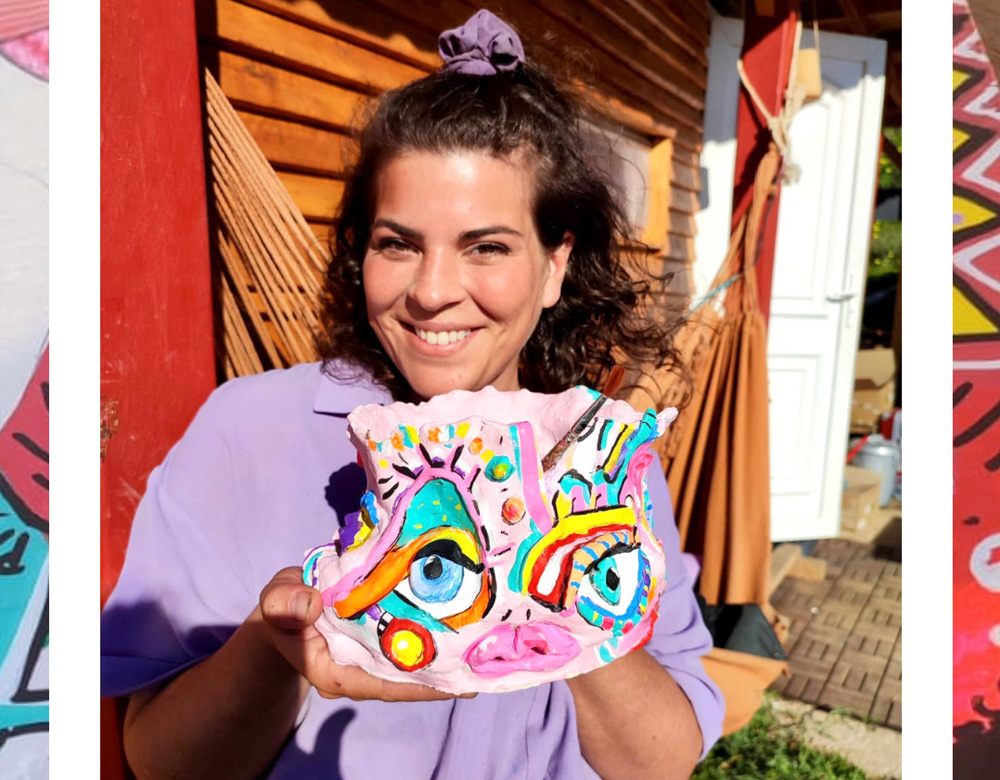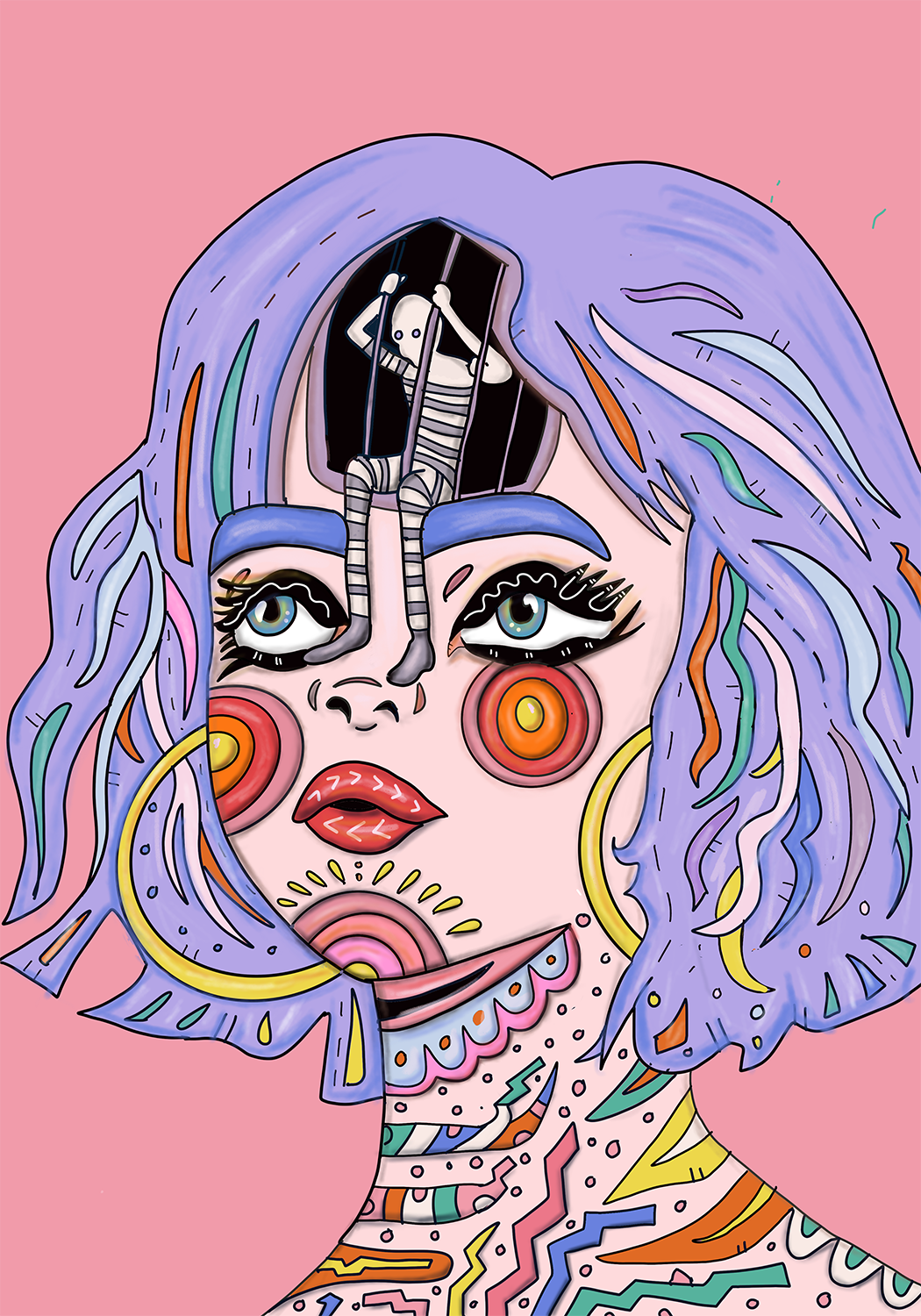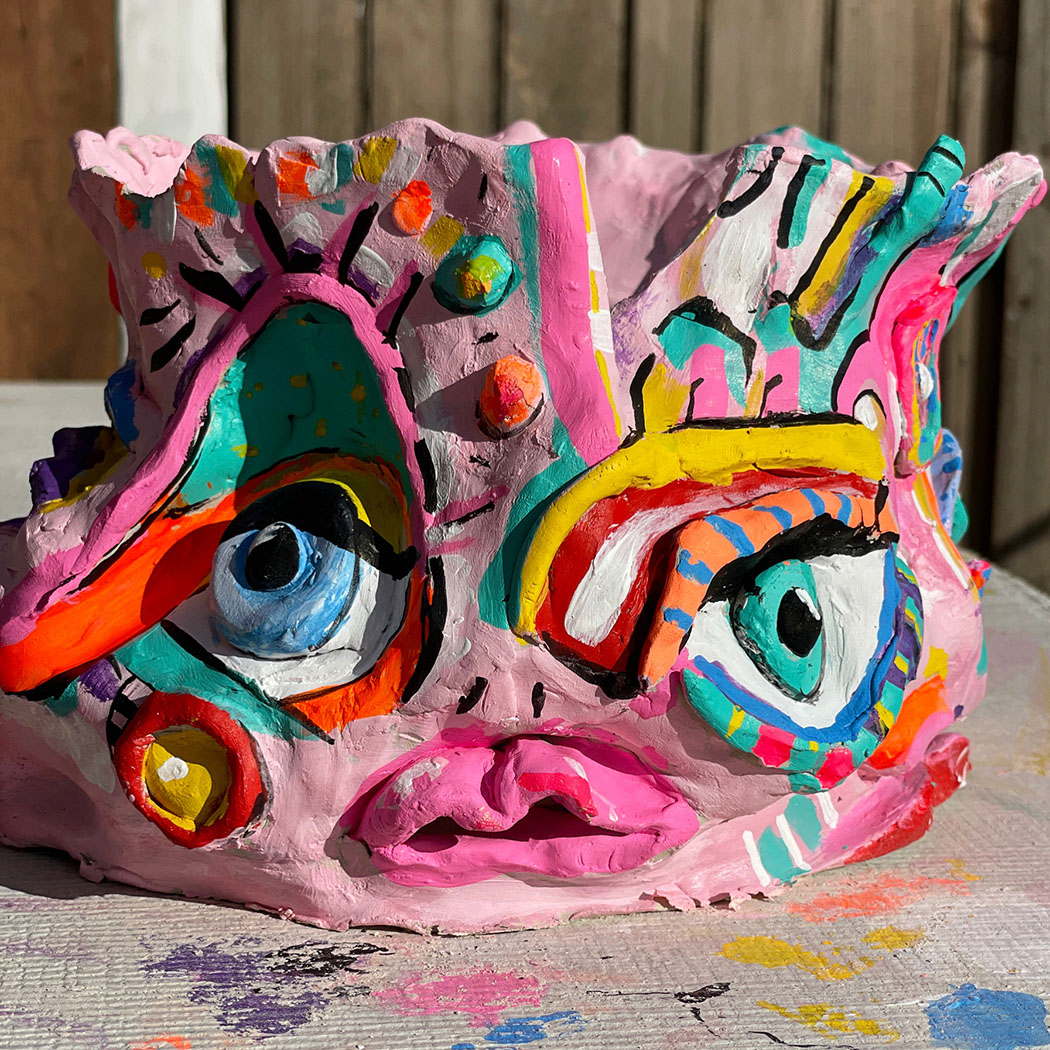Sara Dürst
Year of birth: 1991.
Your education: Bachelor in International Management in Switzerland.
Your discipline: Mixed Media Art, Digital Art, Coloring Book Creator, Educator, Creative Events Coordinator.
www.saraduerst.com | Instagram
Can you tell us about the moment when you realized that art was your true calling, especially after studying economics?
As a child, I was always drawn to creative activities—whether it was drawing, inventing stories, or even making comic books for my brother. I knew I wanted either to do something artistic or work with animals. But as I got older, those dreams started to feel out of reach. I completely lost touch with my creative side during my teenage years and early adulthood.
I chose the “safe” path and started an apprenticeship in the office and went on to study International Management. I kept thinking, “Once I get to the next step, I’ll find something I like—maybe marketing? It’s business, but still creative, right?” I was always focused on the next thing, so I didn’t really question my life choices too much.
But when I finished my studies and started working in the corporate field, it became clear that this wasn’t it. It felt like I was stuck in a loop, and each day started to feel heavier. I began to question, “Is this really what being an adult is supposed to be like?”. The need for a change became too big to ignore. That’s when I decided to take a break and travel through Asia, hoping to find some inspiration and a new direction by talking to people who were doing different things.
Coming back from that trip, I felt a sense of inner security that I hadn’t had before—I knew I would find something that truly resonated with me. So, I entered a phase of experimenting. I read a lot, learned a lot, started to meditate and worked on myself.
I explored web design and online marketing, seeking ways to work more independently. Eventually, I picked up painting again after years of being away from it. What really surprised me was just how much I fell in love with creating art—especially because, for the first time, I was bringing my imagination to life. What started as a simple hobby quickly turned into passion. I’d rush home from work, excited to paint, and often got so lost in the process that I’d forget to eat, only realizing the time when it was nearly midnight. The sense of flow I experienced was incredible, leaving me energized and fulfilled. It took some time, but eventually, I could say, “Yes, I am an artist, and yes, this path is achievable for me.” Looking back, even though I took a few detours, I realize now that they all led me back to where I was always meant to be.
How has living in the Spanish countryside influenced your creative process and the themes you explore in your work?
Living in the Spanish countryside has had a huge impact on my creative process, especially in terms of the materials and mediums I now use. I was painting on canvases with acrylics when I first got here. But renovating an old caravan into a tiny house and art space with a friend introduced me to a whole new set of tools—from machines to woodworking. These skills have become a valuable part of my creative process. We also upcycled a lot of materials, which really trained my eye to see the artistic potential in everyday objects.
Since being in Spain, I haven’t touched a canvas! Instead, I’ve been painting on anything I can find— pieces of wood, discarded materials, you name it. I’ve really embraced upcycling, turning old or overlooked objects into something new and exciting. I’ve also started creating more dimensional artworks, experimenting with different materials like clay and, most recently, gypsum.
As for the themes in my work, mental health continues to be a significant focus for me. But over time, I’ve noticed my art has become a bit quirkier—or as I like to say, “weirder.” I used to draw more traditionally beautiful subjects, but now I’m mostly more interested in creating art that’s “ugly & cute.” It’s a way for me to explore both sides of life: the lovely, colorful, and bright aspects, but also the messier, not-so-perfect parts.
You work with various mediums, from acrylics to upcycled art and digital creations. How do you decide which medium to use for a particular project?
I enjoy working with various mediums, and I tend to switch between them depending on the project or my mood. When it comes to physical art, I really go with the flow. It’s all about the idea I have in mind or what I feel inspired to create in the moment. Whether it’s painting on found objects, upcycling materials, or experimenting with new textures, The hands-on nature of it is something I truly appreciate. Since mistakes are not so easily erased, it really forces me to think creatively and adapt, turning potential errors into something new.
Digital art, on the other hand, plays a different role in my creative process. I often use it for conceptual pieces, client work, or for projects like my coloring book. The flexibility of digital art is fantastic, especially because I can take my iPad anywhere. Wherever I am, it allows me to keep creating, no matter where I am. I find that my digital works often reflect the experiences and encounters I have while I’m on the move.
For example, this summer I volunteered in Pisa with an association that incorporates art therapy. Even while I was there, I could keep creating and process my experiences through digital art. It was a way to make those moments even more memorable and meaningful. So, in a way, the medium I choose depends on the context and how I want to express the ideas or emotions at that time.
Mental health and self-connection are central themes in your work. How do these themes manifest in your art, and what message do you hope to convey to your audience?
Mental health and self-connection are indeed important in my work, and they manifest in various ways, sometimes subtly and sometimes more directly. One of the projects I’m particularly proud of is a coloring book I created, which combines the concept of flow—a state of being fully immersed and focused—with self-reflection exercises. The idea is to help people tap into a relaxed state of mind where they can explore new insights and reflect on their thoughts and feelings through art.
I want to encourage people to engage with their minds actively—seeing the mind as a tool, like a muscle that can be trained. Through my art, I hope to inspire others to overcome limiting beliefs, going more into the flow state, and improve their well-being.
Could you share more about your second (first)! coloring book and how it integrates mental health themes? What do you hope people will gain from engaging with it?
My coloring book, Colorful Reflections, is designed to be much more than just a creative outlet—it’s a tool to help you explore and enhance your mental well-being while nurturing your creativity. Coloring itself can be incredibly powerful for relaxation but with self-discovery, I wanted to take it a step further.
The book is filled with illustrations paired with thought-provoking prompts. These are specifically designed to deepen your understanding of mental health, self-exploration, and self-care. For example, exercises like guiding your life with values, practicing self-affirmation, or going through the process of releasing, accepting, and transforming your thoughts are all part of the experience.
As you engage with the book, not only will you be creating art, but you’ll also be reflecting on important aspects of your life. The final artworks you create can even be used as decorations, serving as daily reminders of the personal growth and insights you’ve gained. My hope is that people will walk away from this experience with a deeper connection to themselves, a sense of calm, and practical tools to continue their journey toward well-being and self-discovery.
You have hosted co-creating events that bring people together through art. What has been the most rewarding aspect of these events for you?
Art, for me, is not just a solitary activity—it’s something that truly comes alive when shared with others. While there are definitely times when we need to retreat into our own space to create, there’s something incredibly powerful about making art together. The connections we form, the energy we share, and the ideas that emerge when we collaborate can be truly transformative.
Creating something as a group brings a sense of satisfaction that’s hard to replicate alone. There’s a special magic in those moments when everyone is in the flow, which is why I named my events “Flow Zone.” Seeing people leave with a good feeling, having actively participated in the creative process, is the most rewarding part for me. It’s even better when they’re inspired to start creating more regularly in their own lives.
Art has this amazing ability to connect us, and when we create together, we not only make beautiful things, but we also build a sense of community and shared experience. That’s what makes it all worthwhile for me—knowing that others are leaving with that same sense of joy and fulfillment.
In what ways do you believe your background in economics has influenced your approach to art, if at all?
I’d say my background in economics hasn’t directly influenced my art—at least not consciously. You won’t find me painting graphs or sketching supply and demand curves, that’s for sure! But the themes of mental health in my work definitely emerged from my time trying to find my place in the corporate world. That experience taught me a lot about the importance of self-care and staying connected to what truly matters.
On the practical side, though, I’m glad I went down the economics path. It’s given me some handy tools for managing the business side of being a self-employed artist and teacher. So while my art might not scream “economics,” the knowledge definitely helps keep the creative chaos somewhat organized!






Leave a Reply